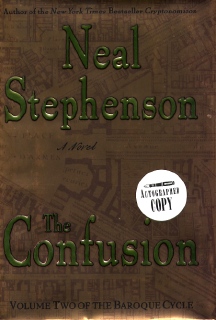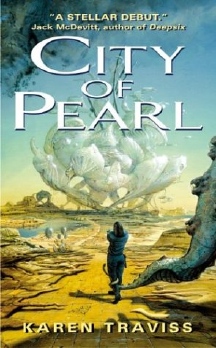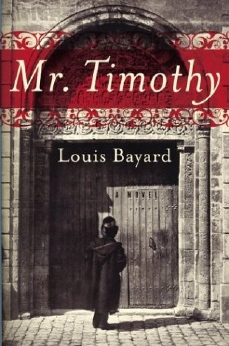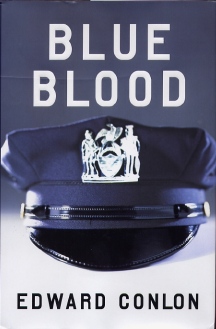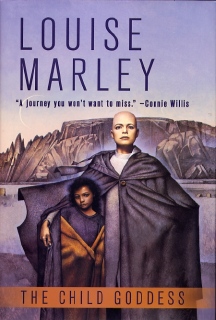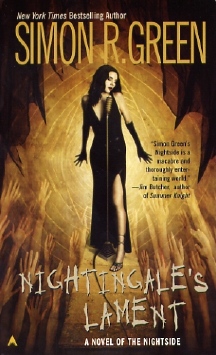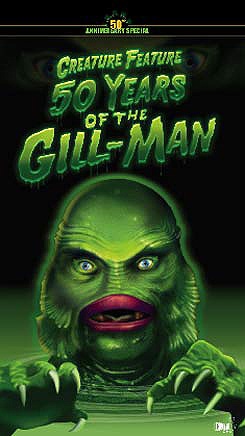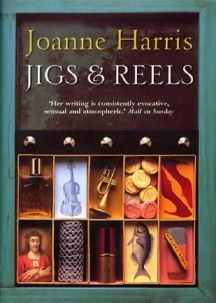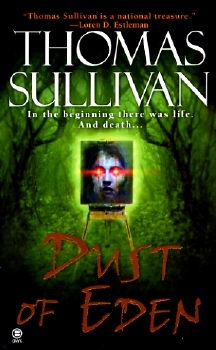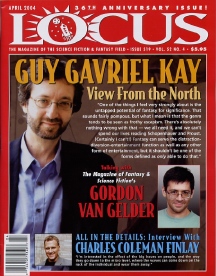|
|
|
This Just in..News from the Agony Column
|
04-23-04: Don't Get Confused About Your Reading Goals |
|||
Neal
Stephenson Delivers 'The Baroque Cycle' in a Timely Manner
Now, in the US, Carroll & Graf did a much better job of publishing and releasing the books. But in general, I've been a bit gun shy ever since. For this series, I don’t suppose that I should sweat it. Stephenson's already finished it and the final book is due out on 9/21/04. We've seen pictures of the cover and I'm sure this is a done deal. Still. Wait for it. Still. With the release of 'The Confusion', I once again toddled to the independent bookstore and found myself an autographed copy, which I duly reproduce here for you. While purchasing it, the clerk, a women with whom I occasionally speak about books (she and I both enjoyed Christopher Brookmyre), asked me if I'd read the first and if I thought it had been worth my time. I had to confess that No, I hadn't read it -- yet, but that Stephenson was on my auto-buy list and I hoped to have the time Real Soon Now. And that Stephenson was rock-solid -guaranteed to be worth reading. I mentioned that John Clute had enjoyed it. I'd forgotten that I live in a rarified world. She replied that she'd probably get round to it Real Soon Now as well -- when the final book was released. So if publishers like to think that setting up books in trilogies or quartets or whatever sells books, they may be right -- but only for the truly compulsive. There are quite a few folks out there who have been stung by annoyingly long release schedules. But I believe that Stephenson and his publishers have done themselves proud by setting up a tight release schedule - so tight that even the most dedicated readers will find themselves pressed to read and finish these books in a timely manner. In the interim, do yourself and your reading life favor by actually rising and walking on your hind legs to trundle out to your local independent bookstore to buy these books. My guess is that you'll be pleasantly surprised to find a nice autographed copy awaiting you. |
|
04-22-04: Reaping the Reader Rewards |
||||||
A
Reader's Suggestions: 'City of Pearl' by Karen Traviss and 'Mr.Timothy'
by Louis Bayard
First, the non-reviewed title, 'City of Pearl' by Karen Traviss. You've got your Environmental Marines, sent to protect the fragile ecosystem of another planet to be colonized by human fundamentalists. There are already four alien races on the planet, so to my mind, it seems a bit crowded already. The space marines hit the ground and the fun begins. If this fun includes tentacled, incomprehensible monsters as illustrated on the cover, well, what more could you ask? Two more books to complete the story, that's what. Because there are clearly not enough trilogies in this world, Traviss has written a story that plays out across three books. And she's apparently good enough a writer to have been offered a Star Wars book. I think that's a good thing. Well, it will certainly pay the bills. Think of it: Star Wars is this author's day job. We hope. Now, lest you think we're all just willy-nilly SF readers here, habituating the Star * sections of the bookstore, here's Troy's review of a considerably different tome, Louis Bayard's 'Mr. Timothy'. I really like the diversity between these two titles. It's an utterly perfect example of why we love reading. And why there are five foot high piles of books around our houses.
Louis Bayard HarperCollins US Trade Hardcover First ISBN 0-06-053421-4 Publication Date: 10-21-2003 384 Pages; $24.95 Date Reviewed: 04-15-04 Reviewed by: Troy J. Knutson © 2004 Let's take an informal poll, an electronic show of hands if you will. How many of us have read 'A Christmas Carol' by Charles Dickens? Great, quite a few of us have. And how many have seen any number of stage, screen or television adaptations of said story? More of you, of course! Well, retain memory of one major character and one minor character from 'A Christmas Carol' (namely Uncle Ebenezer and Tiny Tim), add several decades to the story, and add liberal doses of thriller, mystery and pulp and you'll get 'Mr. Timothy' by Louis Bayard. 'Mr. Timothy' follows the exploits of an independent 23-year-old man making his way through 1860s London. The independent man named Timothy Cratchit is no longer Tiny Tim but stands 5'8” tall while still displaying a slight limp, a reminder of a cured childhood condition. Timothy is trying to go it alone, trying to avoid reliance on Uncle E's generosity. Timothy has sought refuge in a “den of ill repute”, a whore house if you will, and is teaching the madam of the house how to read in exchange for room and board. His other means of income is derived from dredging the Thames for dead bodies with the guidance of his presently landlocked sea captain friend. Timothy comes across several corpses of young girls no older than 12 years of age with distinct signs that connect the two bodies to a single murderer. Enter Philomela, a young Italian girl who is living on the streets and fearful of everyone and trusting of no one. She is somehow connected to the two dead girls. The cast of characters is as colorful and abundant as the original 'A Christmas Carol'. They include Colin the Melodious, a singing street urchin reminiscent of 'Oliver's' The Artful Dodger; Captain Gully, the aforementioned sea captain who pines for his ship, the high seas and a certain class of brown-skinned girls from Majorca; Ophelia Sharpe, the illiterate madam who loves the story/relationship of Robinson Crusoe and his Man Friday; Iris and Mary Catherine, just two of the prostitutes working at Ophelia Sharpe's “Boarding House for Gentlemen”; George, the bouncer/enforcer for Ophelia Sharpe and her ladies; and numerous other major and minor characters that are best left unmentioned so one can savor their appearance. I really enjoyed several aspects of the novel. I love a quick and satisfying read. This novel was both. I appreciate the use of authentic language and phrasing from that time period. "The candles, at least, were new, and the air was quick with oranges and cloves, and there on the hearth, beneath a garland of bay leaves, stood a half-sized Father Christmas, almost sinfully hearty in his purple ermine." Bayard has clearly completed some pain-staking research and attention to detail to get the language of the times just right. One of the problems that can result from using time-appropriate language in a novel is that sometimes the writer can lose the reader's attention by flowering the language and neglecting the storyline. Mr. Bayard does a superb job of packing 14 days worth of action (the majority of the novel covers December 12 through December 26 of 1861) into a compact, thoughtful storyline that explores many topics that could have been used in any number of the present day novels (i.e., pedophilia, white slavery, murder, sadomasochism and religious hippocracy). No, dear reader, this isn't your daddy's Tiny Tim. It's yours and mine and I guarantee you will enjoy the adventures of 'Mr. Timothy' and his motley crew of friends and foes. The only regret I have was not reading Dickens' 'A Christmas Carol' just prior to reading 'Mr. Timothy' for the obvious and inevitable comparisons. |
|
04-21-04: Cop Diary to Blue Blood, Mary Magdalene and the Nightingale's Lament |
|||
Blue
Blood on the Tracks
Edward Conlon is descended from generations of New York cops, good and bad. His great grandfather was a crooked cop who "carried the bag on Atlantic Avenue" during the Tammany Hall era. The blood runs deep. Conlon was born to be a cop, and though he graduated from Harvard -- he still ended up a cop. 'Blue Blood' traces his life from walking a beat in the South Bronx, through his ascent to detective, though his work at the Fresh Kills landfill on Staten island, to sift through the debris of the Twin Towers after 9/11. He's been writing the 'Cop Diary' column for the New Yorker since 1997 under the pseudonym Marcus Laffey. This book has been compared to David Simon's epic 'Homicide', a book cited by both George Pelecanos and David Corbett as a landmark and a cornerstone for all mystery writers. It's my take that first edition/first printings of this novel will become scarce pretty fast. But that's not the reason to run to the bookstore. The reason to run to the bookstore is that Conlon offers a powerful look at America today. Listen to the Terry Gross interview, because Terry Gross is herself immensely talented at bringing out what makes others interesting. There's no doubt you'll find Conlon a gripping, original voice; one that you'll want to read for 559 pages. |
|||
The Child Goddess: Another Ascension Into Hardcover
This is not a huge epic, but looks to be on the taut and terse side of the book-brick divide. It's a traditional story in many ways; Isabel must protect the speechless child from becoming a corporate resource while solving the mystery of why she does not age. The evocative cover art is by John Jude Palencar, who, if I am not mistaken, did the wonderful 'empty cities of the full moon' cover for Howard V. Hendryx. For this reader, I find the endless genre fiction fixation with the many offshoots of the Catholic Church quite fascinating. It seems to me that genre writers are particularly drawn to this religious institution; it crops up in Stephen Baxter's 'Coalescent' and gets some treatment in the latest Alastair Reynolds novel. Marley's in good company. She's got a lot to live up to; including the standards of the Church itself. |
|||
NightSide
Alert: Nightingale's Lament by Simon R. Green
Both Terry D'Auray and I enjoyed the first novel of the series, 'Something from the NightSide', and I also enjoyed the follow-up 'Agents of Light and Darkness'. I keep thinking it's going to be a long time between books, but here's one time that they can't come too fast. The latest novel is 'Nightingale's Lament', and it finds John Taylor searching not for a thing but an answer -- why has a local-to-the-NightSide diva named Nightingale cut herself off from her family and friends? And why are her fans becoming more and more prone to suicide? Unless I miss my guess, big things are brewing in the NightSide and John Taylor will have to use his wits and most importantly, his witty repartee to keep the fabric of reality from unraveling. I say, let it go, let it all come unraveled. But Taylor probably has other ideas. As a reader, I have only one idea: that by 10/21/2004, I'll have yet another John Taylor novel in my hands. That's something worth looking for, and given that these are mass-market paperbacks, we don't need a John Taylor to help us find them! |
|
04-20-04: Creatures, Jigs and Reels |
|||
50 years of the Creature
David J. Schow dropped me a note to let me know that he makes an appearance
in 'Creature Feature: 50 years of the Gill Man', a documentary about the
making of the three principal 'Creature from the Black Lagoon' films. As
someone who built the Aurora Model kit, I have a deep and abiding love
of the green guy. 'The Creature from the Black Lagoon' is one of those
movies that quite surprisingly provides a nicely balanced mix of romance,
terror and mixes up the audience's sympathy for the monster in a fashion
I find to be far under-used in the creature features of today. And of course,
there's the nostalgia factor. I spent many a Saturday afternoon watching
'Creature from the Black Lagoon' and its iterations on 'Chiller', which
was followed by 'The Outer Limits', the latter so lovingly chronicled by
Mr. Schow himself.
Readers can look forward to seeing more of David J. Schow
as he chronicles the making of 'I Robot'; I believe his work will be
featured on the eventual
DVD release of the upcoming movie. |
|||
Joanne Harris Does 'Jigs and Reels'
Readers who have been to the Joanne Harris website of late will notice that Serena's article for The Agony Column has been picked by the author herself for inclusion there. Serena will be reviewing this in-depth in the near future. Also look for Serena's prize-winning story in the UK publication 'The Lady'. It's a major coup for this author, and as ever, I'm proud to be publishing such a talented young lady. |
|
04-19-04: Thomas Sullivan, Pulitzer Nominated Horror Writer, Rounding up this month's periodicals |
|||
From the Pulitzer to the Pulps
His first novel, back in 1988, was 'The Phases of Harry Moon'. It's a slightly absurd coming-of-age tale about four quirky brothers that was nominated for the Pulizter. It's wild stuff, having a one-time PP wrirter churning out paperback novels. They look to be pretty entertaining. 'Dust of Eden' concerns the woman who finds the dust of Eden, that blood-red dirt from the creation of the world. Talk about mysterious ways! When a bit of the ol' garden ends up in the hands of an elderly woman, she's forced to dress like a man and hijinks ensue; no wait, that's from the humor shelf. Ah. From the horror shelf, right next door, we see that Ariel Leppa is an elderly woman who acquires some of this mysterious dust, giving her ferocious power. She uses this power to help her at the New Eden rest home. There, she's able to improve her guests' health to the point of bringing the dead back to life. Of course, I'm saying that like it's a good thing, but you know it isn't. This being Eden, there's likely to be a serpent about, a snake with some bad intentions. One of the great things about genre fiction is the huge number of talented writers hiding behind covers that would embarrass even the thickly-skinned. Now Sullivan's cover is by no means embarrassing. It could have popped up on the shelves any time in the past 20 years. In fact, this has the feel of vintage 1980's horror fiction. Slowly, surely, it's crawling out of the closet. Aided and abetted by good writers and publishers scared shitless of flooding the market with crap, we should have a nice careful rebirth on our hands. Along with the usual cleanup afterwards. |
|||
To
India With Jesus
Don't think you're going to miss the cover of the latest Fortean Times
on this website. Not while I still have one of the 5,800 or so pennies
required to afford a subscription. Not while I have the disk space on
my server for the pictures. Not while the scanner scans, the Graphic
Converter converts or the Dreamweaver weaves this particular dream for
you. This time around, since we're all feeling rather Holy and all,
it's Jesus in India. Had to grow a couple of arms to make the journey.
Within, there's a tumor picture straight out of Skin Disease Weekly
(sadly no longer online) that's likely as not to make you gag, a Cyclops
rabbit and big ol' printout
of that exploded whale picture from Japan. The Fortean Traveler visits
Snorri Sturluson's hot tub (his Prose Edda is one of the earliest written
works of literature), and you get a hilarious review of The
Third Movie by Mel Gibson ("every age gets the Jesus
film it deserves"),
and -- all hail! -- a visit to Marpingen to investigate the Marian visions
there,
covered in such enticing, exciting detail by David Blackbourn in his
book 'Marpingen'. |
|||
From Locus With Love
Pay close attention to the interview with Gordon Van Gelder. It's really quite interesting, and essential reading for those who hold out hope for the future of short fiction. Recall as well that Van Gelder is the man who started the career of George Pelecanos (as revealed by Pelecanos in his interview [MP3,RA]), and you'll find a long and sterling track record discussed in fascinating detail. |
